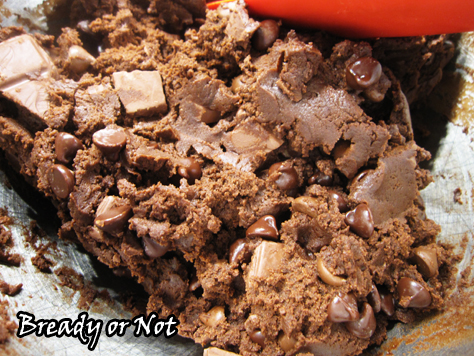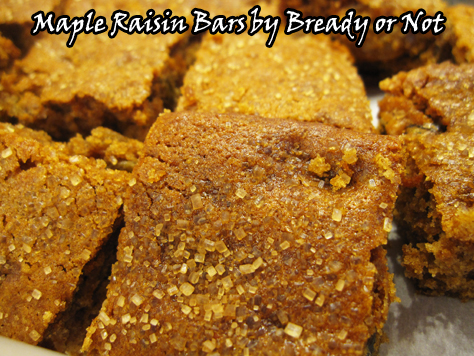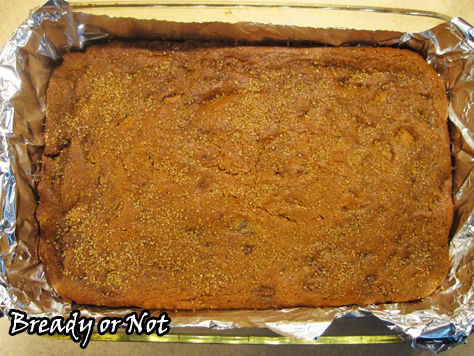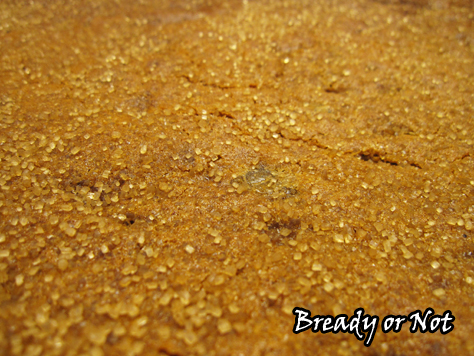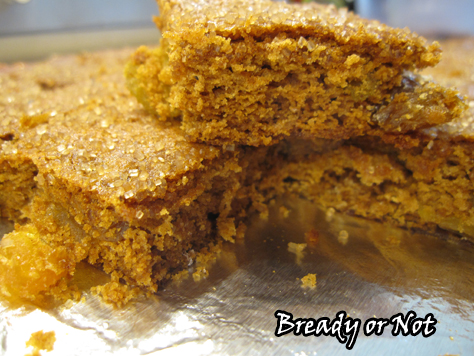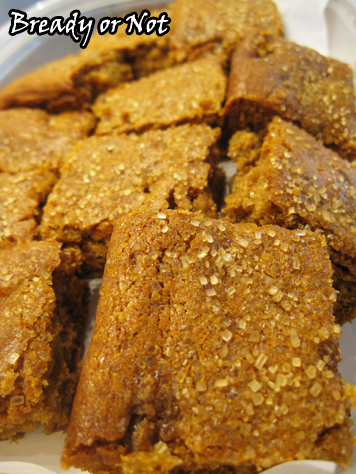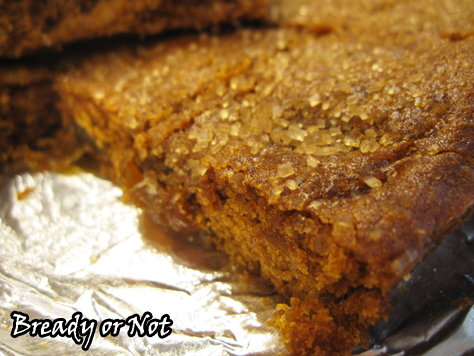Bready or Not: Loaded Chocolate Chip Pudding Cookies
Hey, it’s been a few weeks since I featured chocolate, so let’s indulge hardcore with some Loaded Chocolate Chip Pudding Cookies.
There are a lot of similar pudding-based chocolate chip cookie recipes on food blogs. Some use terms like double, triple, or quadruple chocolate. Me, I’m calling them LOADED.
Use whatever chocolate you want. Mix ‘n match chocolate chips. Chop up some holiday candy bars. Throw in two cup’s worth, and these cookies will be good to go. In your mouth.
I’ve used pudding mix in other cookies and cakes before, with reason. It creates tender, delicious dough that also keeps well. In this case, it makes fat chocolate cookies. You’ll want to squish the dough balls, because they won’t spread much when they bake.
The result is a cookie that will make chocoholics flail in delight. These things are thick, luscious, and, well, loaded with chocolate.
Bready or Not: Loaded Chocolate Chip Pudding Cookies
Ingredients
- 2 1/4 cups all-purpose flour
- 1/2 cup Dutch-process cocoa powder sifted
- 1 teaspoon baking soda
- 3/4 cup unsalted butter softened
- 3/4 cup brown sugar packed
- 1/4 cup white sugar
- 3.9 ounce instant chocolate pudding 1 box, NOT Cook N' Serve or Sugar-Free
- 2 eggs room temperature
- 2 teaspoons vanilla extract
- 2 cups chocolate chips or chopped chocolate bars, any kind
Instructions
- In a bowl, mix together the flour, cocoa powder, and baking soda.
- In a large bowl, cream together butter, brown sugar, and granulated sugar until fluffy. Add the pudding mix powder.
- Beat in the eggs and vanilla extract. Slowly add the dry ingredients into the wet until just combined. Fold in the chocolate.
- Wrap the dough in plastic wrap and tuck into the fridge to chill for several hours or overnight.
- Preheat oven at 350-degrees. Use a tablespoon scoop to dollop the dough onto a cookie sheet. The cookies won’t spread much, so flatten them a bit. Bake for 9-12 minutes, or until the cookies are set. Let them settle on the cookie sheet for a few minutes and then transfer to a rack to completely cool.
- OM NOM NOM!
Sunday Quote doesn’t want summer yet
Read More“Being a writer is a very peculiar sort of a job: it’s always you versus a blank sheet of paper (or a blank screen) and quite often the blank piece of paper wins.”
~Neil Gaiman
Bready or Not: Maple Raisin Bars
If you like chewy maple goodness, then these Maple Raisin Bars are for you!
So you ever look at a recipe and think, “Hey, that looks good, but I want to change half the ingredients around?” That’s how this recipe came about. I look at another recipe and decided to give it an overhaul. Golden raisins instead of apricots. Honey instead of molasses. And so on.
The result? Chewy, cakey bars with delightful gems of golden raisins sprinkled throughout. The turbinado sugar on top adds a special sparkle.
They taste kind of like gingerbread just, well, without any ginger. That’s the closest comparison I can make.
Even better, these keep well for days at room temperature, and they can also be frozen for later enjoyment.
Yep, these will be greatly enjoyed. Now or later.
Bready or Not: Maple Raisin Bars
Ingredients
- 1 cup bread flour
- 1/2 cup all-purpose flour
- 1 teaspoon baking soda
- 1 teaspoon ground cinnamon
- 1/2 teaspoon ground nutmeg
- 1/4 teaspoon ground cloves
- 1/4 teaspoon salt
- 1 cup golden raisins
- 3/4 cup maple sugar
- 1/2 cup avocado oil or canola oil
- 1/3 cup honey
- 1/2 cup milk or almond milk
- 3 teaspoons turbinado sugar
Instructions
- Preheat oven at 350-degrees. Line a 9x13 pan with aluminum foil and apply nonstick spray or butter.
- In a large bowl, combine the flours, baking soda, cinnamon, nutmeg, cloves, and salt. Stir in the raisins. Set bowl aside.
- In a medium bowl, whisk together maple sugar, oil, honey, and milk. Slowly pour the wet ingredients into the dry until fully combined. Scrape the dough into the prepared pan, making sure the raisins are well distributed. Sprinkle turbinado sugar all over the top.
- Bake for 24 to 28 minutes, until the dough has puffed and it passes the toothpick test in the middle.
- Let it cool completely. Lift out of pan with the foil and cut into squares. Store in a sealed container with waxed paper or parchment paper between the layers. Will keep well at room temperature for days, or can be frozen for weeks.
- OM NOM NOM!
Start Writing Poetry (Again?) During National Poetry Month in April
Some people describe poetry as a lost art, the sort of effort confined to previous decades or ennui-filled teenage years. Poetry isn’t dead, though. For writers of science fiction and fantasy poetry, the opportunities abound.
Since National Poetry Month is coming up in April, this is a good time to sharpen your pencils (or blow the crumbs out of your keyboard) and embrace your inner poet for the first time in years. Here’s some advice to get you started.
 1) Take advantage of Poem-a-Day Challenges
1) Take advantage of Poem-a-Day Challenges
I have published over 100 poems in recent years. I write almost all of those works in the months of November and April, because that’s when the Writer’s Digest Poetic Asides Blog runs the Poem-a-Day challenge. The full challenge involves submitting a collection of works to be considered for chapbook publication, but I just use PAD for the daily poem prompts posted by Robert Lee Brewer each morning. Some participants post their work in comments there, but I don’t advise doing that if you want to submit your poems for magazine publication. You don’t want to give away your first rights for free!
If a prompt doesn’t click for you, find inspiration elsewhere. I usually need to do that a couple times during PAD. I find substitute prompts by scrolling down on the Poetic Asides site to look at the weekly prompts Brewer posts year-round. After all, the ultimate goal is to write a poem each day during the month. The original prompt doesn’t really matter in the end.
When the month is done, I go through my poems to cull, and then I start to revise the salvageable ones.
2) Say it out loud
Revising any work of writing can be a frustrating effort. With poetry, rhythm and flow is vital. Reading out loud helps you to find the flow and eliminate excess words. It’s a good way to find typos, too.
3) Know where to find markets
The Science Fiction Poetry Association’s site offers a good (but not comprehensive) list of poetry markets. New markets open all the time. Other venues will shut down for periods. Others shut down permanently. As you track your submissions, keep up with favorite markets so that you know when they open or close to submissions. The best way to find out about new magazines is to network with other writers through web forums or social media like Twitter.
4) Guidelines to submit work
I wish this had a straightforward answer, but there is no industry standard. You have to carefully read the guidelines for each publication–and don’t trust those guidelines to remain the same from week to week, either.
Many markets use Submittable as their submission platform, so it’s worthwhile to set up an account there. Others rely on email, and requirements may include sending poems in the body of the email, or to only submit poems via attachments in certain file types. Most markets allow a poet to send in anywhere from 3 to 5 poems at a time. This is great after an effort like Poem-a-Day, when you have a batch of poems ready to send out into the world. The only bad side of that is the responses often come in batches as well, so brace yourself to get the lot rejected in one fell swoop.
5) Submit, submit, submit
When I first started writing poetry again a few years ago, I wasn’t confident in my poems. I was becoming an old pro at short story rejections and sent my works out right away after they were turned down, but I had a harder time doing that with poetry. Poetry rejections felt more personal because my poems were more personal.
Here’s the thing. Editors have different tastes and different moods. You never know when a poem will resonate with an editor; you have to make yourself vulnerable, submit your work, and submit again if necessary. Expect rejection.
I have had several poems that racked up ten, fifteen rejections before finding a home. Some have made a circuit of markets over periods of two and three years. A poem might wallow in the slush pile of a magazine for several months, get rejected, wallow on my computer for a few months as I wait for an appropriate market to open, and so on. The long wait is worth it to get an acceptance at long last.
Best of luck in April, poets!
Read MoreLocus Awards 2017 – Novel Consideration
It’s time to send in nominations for the Locus Awards! As you might recall, Clockwork Dagger was a finalist two years ago. It’d be spiffy to make the list again. My novel Breath of Earth is already on the ballot in the Fantasy category!
One thing that sets these awards apart from the other major genre awards is that ANYONE can vote. All you need to do is fill in your name, email, and vote in whatever category you want. The ballot is huge. You don’t have to fill in everything.
Take a look and vote! The deadline is April 15th.
#SFWAPro
Read More




